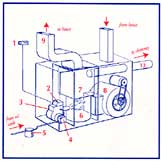No matter which fuel your system uses, the heat it creates is distributed throughout your home in one of three ways: hot water (baseboard), steam (radiators) or warm air (vents). Two are described here. While the system you have may look a bit different, it operates on the same principles as those below.
How Oil Systems Make Heat

Warm Air System

Hot Water System
Your thermostat (1) has a sensor that measures room temperature. When the temperature drops below your thermostat setting (or you raise the level above the room temperature), it sends a signal to the controls (2) on your burner (3) to get into action.
A fuel pump (4) draws oil through a filter (5) to your burner. It turns this oil into a fine spray, mixes it with air and ignites it in the combustion chamber (6), causing the chamber to get very hot.
What happens next depends on the type of system you have:
- If you have a Warm Air System, air absorbs heat in your furnace's heat exchanger (7). A blower (8) sends this air through ducts (9) to heat your home.
- If you have a Hot Water (hydronic) System, water circulates around your boiler's heat exchanger (10). A circulator (11) pumps the hot water through radiators or baseboards. An expansion tank (12) adjusts to varying pressures. Eventually, the water or air returns to the unit to begin the cycle again.
- Steam systems work similarly to hot water systems, except that steam is generated and rises to the radiators. (No circulators are needed.) A low-water cutoff prevents damage to the boiler by shutting it down in case water levels drop too low.
- In all systems, the combustion emissions go up the flue (13), never mixing with either the air or water circulating through your home.







